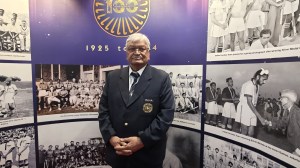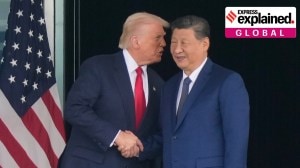1943: A Love Story
SEATED below a fading portrait of Netaji in full battle regalia, Capt SS Yadav, 88, looks around the 8x6 room in an undistinguished commerci...

SEATED below a fading portrait of Netaji in full battle regalia, Capt SS Yadav, 88, looks around the 8×6 room in an undistinguished commercial complex in North Delhi. ‘‘Bose babu taught us, for the very first time, that independence was something honourable,’’ he says. ‘‘He spoke to our heart of hearts, that secret place where we wanted India to be free.’’
Secret, because Yadav and his comrades still wore the colours of the British Indian Army. The year was 1943, the place was Singapore. Ferried across the ocean to fight the ruler’s war in the Pacific theatre of World War II, they suddenly found themselves faced with the option of a very different battle. For life, liberty, dignity. For Independence.
Sacrifice is just another big word—if not an Elton John song—for Midnight’s Children and their progeny. But for Bose’s patchwork army, it defined their lives.
With Bose himself relegated to two lines in school history texts, the force he raised remains a mere footnote, remarkable only to the sharp eyes that notice a well-worn INA insignia pinned to a turban or lapel, or grasp their ramrod stance for the military bearing it is.
Only a handful of this remarkable army survives now—Yadav, general secretary of the All-India INA Veterans’ Committee, puts the figure at 3,000, though the government distributes some 20,000 pensions—and, till a few years ago, they could have been your favourite school teacher (with a special talent for history), the landlord of a rural enclave in South Delhi, or even the painstaking projector operator at a single-screen cinema.
It’s a line unconsciously echoed by Capt Lakshmi Sehgal, the most famous living INA veteran. Based in Kanpur, she says unequivocally: ‘‘The INA was the most wonderful part of my life.’’ Everything else, even the race for President—Sehgal and APJ Abdul Kalam were contestants for the seat in 2002—pales in comparison.
| We were a small force, poorly equipped. It was a losing battle, but we were ready to do undergo everything for him Capt Lakshmi SehgalWe were a small force, poorly equipped. It was a losing battle, but we were ready to do undergo everything for him Capt Lakshmi Sehgal |
Hearing Lt Hari Ram say it, it’s easy to figure out why. As the octogenarian reminisces, the whitewashed walls and inexpensive furniture give way to visions of dense jungle, torrential rain and desperate men marching on empty stomachs. ‘‘Malaria and dysentery, those were two enemies we were not prepared for in the jungles of Burma. It was March 1944. We were moving towards the Indo-Burma border, and the British were bombing indiscriminately. A bullet grazed my head,’’ he parts his wispy silver hair to indicate the place, ‘‘but I survived.’’
Rations were non-existent; the men were instructed to grab whatever they could from enemy ranks. ‘‘But village after village was deserted. We were carrying rice in socks in our backpacks—that was the custom—but we had no water to cook it in. We were dying of thirst, when I spied a puddle. I scooped up the water—the dregs didn’t come up. We used that water to cook rice.’’
Meerut-born Hari Ram was a Lance Naik in the Hong Kong-Singapore Royal Artillery—a special regiment that accorded Indians British ranks—when he was shipped off to Singapore for training in 1940. Most INA inductees, however, were drawn from the British Indian Army. ‘‘After the Japanese beat back the British, all Indian PoWs, some 50,000 of us, were housed in the Vidyadhari camp. At firebrand leader Rashbehari Bose’s request to the Japanese command, we were by and large treated humanely,’’ says Yadav.
Lt Harbans Singh takes up the story. ‘‘In February 1942, all of us gathered at Ferrer Park, a huge maidan in Singapore. Captain Mohan Singh—he was the first Indian officer to have been taken prisoner—and Major Fujiwara of the Japanese army addressed us, saying the Asian brothers must get together to drive out the Anglo-Americans. They asked volunteers to raise their hands. I raised both.’’
In every sense of the term. ‘‘Within a few weeks of taking charge, he made a nation of us. We ceased to identify ourselves by religion, caste or birthplace, we called ourselves Indians. We didn’t greet each other with a ‘Ram Ram’ or ‘Salaam Alaikum’, we said ‘Jai Hind’. We had Hindus, Christians, Muslims eating meals cooked in one kitchen at one table,’’ Yadav paints a picture of a Utopian mini-India.
Such was the charisma of the man, Sehgal’s voice breaks on the line from Kanpur. ‘‘It was his utter and complete sincerity that drew people to him. We were a small force, we were poorly-equipped, it was a losing battle, but we were ready to undergo everything with him.’’
And they really were ready for everything. ‘‘When my school friend Davinder Nath Mohan and I joined the Indian Independence League in 1943, we had our initials tattooed on our right arms,’’ says Dalip Singh Kapoor, 78, showing off the smudged blank ink, ‘‘just so our bodies would be identified should we be killed.’’
Born into a Sikh textile tycoon’s family settled in Burma’s Yawnghwe state for three generations, Kapoor found himself looking after the backroom instead of manning the front. ‘‘I recruited almost 150 men for the INA, 12 girls for the Rani Jhansi regiment,’’ he remembers, ‘‘and raised Rs 29 lakh for the forces. Besides, my grandfather’s company supplied the khaki khadder for the INA uniforms.’’
Idealism, commitment and bravery notwithstanding, surrender was perhaps inevitable. Those who survived the Arakan jungles found themselves in detention camps in what is now Bangladesh; some were flown to Multan. ‘‘We were divided into three categories, grey, dark grey and black, depending on the degree of ‘disloyalty’. I found myself in dark grey,’’ chuckles Singh.
And then? ‘‘Netaji had said, ‘Chalo Dilli!’ So I came here,’’ says Bael Bahadur, 83. The INA Veterans’ Committee found the little-educated Nepali a job as a cinema projector-operator. The never-say-die Hari Ram went on to join the Delhi Fire Brigade, while Harbans Singh worked as an airfield mechanic. Marriage and children followed and the demands of keeping body, soul and family together gradually drew the curtains over the best days of their lives.
Except on occasions when subsequent generations try to make amends. That’s when Singh’s INA pin comes out. And Yadav’s plaque in Roman Hindi, the language Netaji wanted to use to unite India. The dates are brushed up, the battles relived. And the rheumy eyes shine again.





- 01
- 02
- 03
- 04
- 05


























